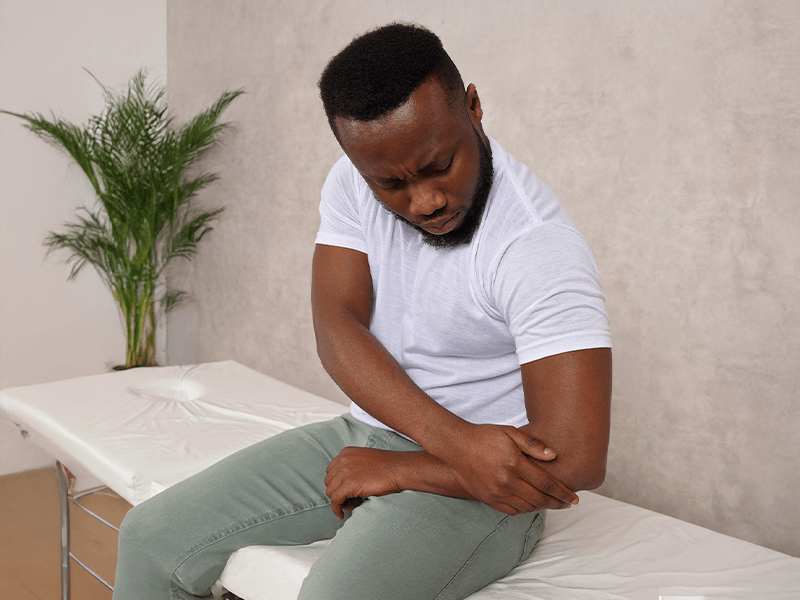Search
Find a Physician
Medically Reviewed by
Christian J. Zaino, MDBlog
Apr 15, 2025
Everyone’s heard of tennis elbow—but that’s exactly the problem. When something sounds familiar, we tend to assume we already understand it. That stops us from learning what really matters. And with tennis elbow, that can lead to years of unnecessary discomfort. For starters, you don’t need to play tennis to get it.
This condition, officially known as lateral epicondylitis, can affect anyone who repeats the same arm motions, whether you’re typing at a desk, using hand tools, or lifting boxes. Another myth? That only athletes or older adults are at risk. In reality, it can sneak up on just about anyone.
So if you’ve been brushing it off, thinking it’s just for pros with rackets, now’s the time to reconsider. Tennis elbow prevention isn’t about avoiding a sport—it’s about protecting your muscles and tendons from overuse. Let’s set the record straight and explore what works to keep your arms pain-free.
Tennis elbow, or lateral epicondylitis, is a condition that causes pain around the outside of the elbow. It happens when the tendons in your forearm muscles develop small tears from overuse, especially near the bony bump on the outside of the elbow. The tendon(s) involved are known as the common extensor tendons - the tendons that extend your fingers and wrist. This slight tear causes pain and tenderness that can make even simple tasks, like lifting a coffee cup, uncomfortable. Despite its name, lateral epicondylitis does not involve any inflammation. It is believed that this condition occurs in an area of poor blood supply and poor capacity to heal the small tears. The inciting factor is most commonly triggered by repetitive wrist and arm motions that strain the tendon over time.
If you're wondering what causes tennis elbow, here are some common activities and risk factors to keep in mind:
Understanding what causes tennis elbow is the first step toward preventing it and making smarter choices in your daily routine.
Let’s be honest—nobody sits around feeling perfectly fine and suddenly thinks, “I bet I have tennis elbow.” It’s the discomfort that grabs your attention, often showing up in small ways that become hard to ignore. The symptoms are what spark that first search, and if you know what to look for, you can catch it early and act before it gets worse.
Recognizing these early signs can make a huge difference. That’s why understanding symptoms is a vital part of tennis elbow prevention—spot it early, and you can keep it from becoming a long-term issue.
The fastest way to cure tennis elbow is rest—plain and simple. Giving your tendons a break from the motion that caused the pain in the first place is the most effective first step. It’s tempting to power through the discomfort, but doing so can stretch your recovery from a few weeks to several months.
Once you’ve cut back on the activity that triggered it, there are several ways to relieve the pain and help your elbow heal:
You see, relief isn’t just about getting rid of the pain—it’s about setting your elbow up for long-term recovery. A mix of rest, smart therapy, and patience is your best bet for both short-term comfort and long-term healing. “Tennis elbow was one of the most common problems I see. It is very annoying for the patient, and the pain can persist for months, if not over a year. The counterforce elbow brace and a home exercise program have been found to be instrumental in alleviating this annoying elbow pain. However, if pain persists, there are other more aggressive options to discuss.” - Dr. Christian Zaino
Preventing tennis elbow starts with being mindful of how you use your arms and wrists during repetitive tasks. Whether you’re lifting, typing, or swinging a racket, proper form makes a huge difference. Focus on posture, take breaks, and don’t overdo the same motion for too long. Strengthening your forearm muscles and stretching regularly also helps keep your tendons more resilient.
If your job or hobby involves repetitive strain, consider using ergonomic tools or wearing a supportive brace during high-risk activities. These small changes go a long way in protecting your elbow over time. Tennis elbow prevention isn’t just for athletes—it’s something everyone should keep in mind to avoid future discomfort and downtime.
Tennis elbow prevention isn’t just a concern for athletes—it’s something anyone with repetitive arm movements should take seriously. Understanding the symptoms, causes, and relief options gives you the upper hand in dealing with this common but frustrating condition. You don’t have to wait until the pain becomes unbearable to act.
By recognizing the early signs and adjusting your habits, you can protect your tendons and avoid long-term discomfort. Whether you’re lifting weights, typing for hours, or doing weekend DIY projects, a few small changes make a big difference. Your elbows will thank you for taking the time to care.
Prevent tennis elbow before it starts—discover expert tips for relief and prevention from the Orthopedic Institute of NJ today!
OINJ PHYSICIAN’S ADVICE
Tennis elbow was one of the most common problems I see. It is very annoying for the patient and the pain can persist for months if not over a year. The counterforce elbow brace and a home exercise program have been found to be instrumental in alleviating this annoying elbow pain. However, if pain persists, there are other more aggressive options to discuss.
Christian J. Zaino, MD
Orthopedic Surgery, Hand & Wrist

